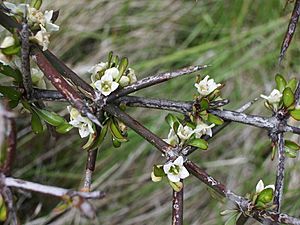Matagouri facts for kids
Quick facts for kids Matagouri |
|
|---|---|
 |
|
| Scientific classification | |
| Genus: |
Discaria
|
| Species: |
toumatou
|
The matagouri (scientific name: Discaria toumatou) is a unique plant found only in New Zealand. It's known for its many tangled, thorny branches. People sometimes call it "wild Irishman." The name "matagouri" comes from how English speakers heard the Māori name "matakoura" in the South Island. It is also known as tūmatakuru.
What is Matagouri?
Matagouri is a bushy shrub or small tree that can grow up to five metres (about 16 feet) tall. It has many branches that grow in all directions, making it look very tangled. Its most noticeable feature is its very sharp thorns. Small, tough leaves grow close to these thorns, but you'll mostly see them in spring or in shady spots. The flowers are tiny, white, and don't have petals. Matagouri is special because it's the only native New Zealand plant that has thorns!
Where Does Matagouri Grow?
You'll often find matagouri in areas with tussock grass, rocky ground, and along riverbeds. It's very common in the eastern part of the South Island. You can also find it in a few places along the coast of the North Island, south of the Waikato River.
Like other plants in its family, matagouri helps the soil. It can take nitrogen from the air and turn it into a form that plants can use. It does this with the help of tiny living things called bacteria, which live in its roots. This process is called nitrogen fixation.
Matagouri often grows near other plants like mingimingi (Coprosma propinqua), porcupine shrub (Melicytus alpinus), and native brooms (Carmichaelia species). Sometimes, it also grows with an introduced plant called sweet briar (Rosa rubiginosa), which is considered a weed.
Protecting Matagouri
Because matagouri is a native plant, it is protected in New Zealand. On public land, it has full protection. On private land, it also has some protection under a law called the Resource Management Act 1991. This helps make sure this special thorny plant continues to thrive in New Zealand.

